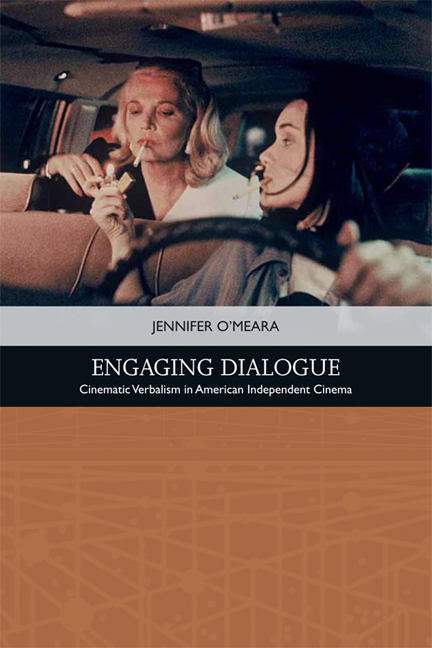Book contents
- Frontmatter
- Contents
- List of Figures
- Acknowledgements
- Introduction
- 1 Measuring Engaging Dialogue
- 2 Verbal-Visual Style and Words Visualised
- 3 The Integrated Soundtrack and Lyrical Speech
- 4 Dialogue and Character Construction
- 5 Embodying Dialogue: Rich Voices, Expressive Mouths and Gesticulation
- 6 Gendered Verbal Dynamics: Sensitive Men and Explicit Women
- 7 Adapting Dialogue and Authorial Double-voicing
- Conclusion: Verbal Extremes and Excess
- Filmography
- Bibliography
- Index
Introduction
Published online by Cambridge University Press: 01 May 2021
- Frontmatter
- Contents
- List of Figures
- Acknowledgements
- Introduction
- 1 Measuring Engaging Dialogue
- 2 Verbal-Visual Style and Words Visualised
- 3 The Integrated Soundtrack and Lyrical Speech
- 4 Dialogue and Character Construction
- 5 Embodying Dialogue: Rich Voices, Expressive Mouths and Gesticulation
- 6 Gendered Verbal Dynamics: Sensitive Men and Explicit Women
- 7 Adapting Dialogue and Authorial Double-voicing
- Conclusion: Verbal Extremes and Excess
- Filmography
- Bibliography
- Index
Summary
This book examines the centrality of dialogue to American independent cinema, arguing that it is impossible to separate small budgets from the old adage that ‘talk is cheap’. Yet, as the creativity of the resulting indie dialogue reveals, this is no bad thing. With a focus on the verbally creative works of Wes Anderson, Noah Baumbach, Hal Hartley, Jim Jarmusch, Richard Linklater and Whit Stillman, the book aims to demonstrate the ability of dialogue to engage audiences and bind together the narrative, aesthetic and performative elements of selected independent cinema, from the 1980s until the present day.
While it may come as a surprise to anyone who has ever quoted a favourite line of film dialogue, cinema is still considered a visual rather than a verbal medium. But what makes certain dialogue pleasurable for an audience, and should we only praise speech that is easily extracted and repeated? Furthermore, do certain filmmakers have an identifiable verbal rather than visual style? By examining the design and execution of dialogue from multiple perspectives (sound and image, characterisation, performance, gender, adaptation and authorship), I develop an integrated framework for understanding how dialogue functions, at the level of an individual or group of filmmaker(s). When compared to the dialogue norms of more mainstream cinema, the verbal styles of these independent writer-directors are found to be marked by alternations between various extremes, particularly those of naturalism and hyperstylisation, and between the poles of efficiency and excess. More broadly, these writer-directors are used as case studies that allow for an understanding of how dialogue functions in verbally experimental cinema, which, this book contends, is more often found in ‘independent’ or ‘art’ cinema. A receptionfocused approach is taken to the design and execution of their dialogue, in order to analyse how they craft speech that engages audiences in rewarding ways.
In order to capture the centrality of dialogue to the work of these writerdirectors, I coin the term cinematic verbalism, and the related label of cinematic verbalists, to refer to their work. The label takes as its basis the standard definition of a ‘verbalist’ as someone who is skilled with words, but, since it is partly the ways that dialogue is embodied and integrated that gives their speech a medium-specific quality, the ‘cinematic’ component is crucial.
- Type
- Chapter
- Information
- Engaging DialogueCinematic Verbalism in American Independent Cinema, pp. 1 - 10Publisher: Edinburgh University PressPrint publication year: 2018



